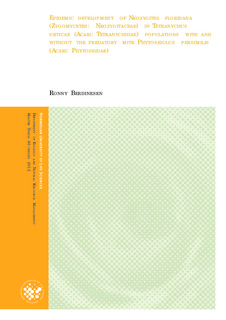Epidemic development of Neozygites floridana (Zygomycetes: Neozygitaceae) in Tetranychus urticae (Acari: Tetranychidae) populations with and without the predatory mite Phytoseiulus persimilis (Acari: Phytoseidae)
Master thesis
Permanent lenke
http://hdl.handle.net/11250/187101Utgivelsesdato
2012-10-03Metadata
Vis full innførselSamlinger
- Master's theses (INA) [593]
Sammendrag
The entomopathogenic fungus Neozygites floridana is an important natural enemy of the two- spotted spider mite Tetranychus urticae. In order to investigate how the predator Phytoseiulus persimilis affects the transmission of N. floridana to T. urticae, a preliminary experiment on establishing the climatic conditions in a climatic chamber for an N. floridana epizootic were conducted. Bean plants (Phaseolus vulgaris), T. urticae and two different isolates of N. floridana were used as a model system in plexiglass cages. Ambient relative humidity (RH) and temperature (˚C) set at a constant of 70% and 18˚C, respectively, led to an epizootic outbreak of a Brazilian N. floridana isolate, but not a Norwegian N. floridana isolate. Recordings of the microclimatic RH and temperature 5mm underneath the boundary layer of P. vulgaris leaves revealed higher RH and temperature compared to the ambient conditions.
In this laboratory experiment, T. urticae exposed to N. floridana and P. persimilis simultaneously seem to have a higher prevalence of N. floridana compared to T. urticae exposed to N. floridana only. Ten days after inoculation with N. floridana, 59 % of the P. persimilis exposed T. urticae contained N. floridana hyphal bodies. In comparison, the level of hyphal bodies in the non- exposed T. urticae was 29 %. These differences were significant (P= 0.008). Although not significantly, this trend continued throughout the experiment. However, the amount of T. urticae with infective capilliconidia attached to the body ten days after inoculation with N. floridana was higher in the cages with non- exposed T. urticae (18% vs 11%, P= 0.015). This trend continued throughout the experiment, but not significantly except for the last sampling day.
